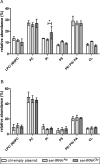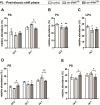Errors in protein synthesis increase the level of saturated fatty acids and affect the overall lipid profiles of yeast
- PMID: 30148852
- PMCID: PMC6110467
- DOI: 10.1371/journal.pone.0202402
Errors in protein synthesis increase the level of saturated fatty acids and affect the overall lipid profiles of yeast
Abstract
The occurrence of protein synthesis errors (mistranslation) above the typical mean mistranslation level of 10-4 is mostly deleterious to yeast, zebrafish and mammal cells. Previous yeast studies have shown that mistranslation affects fitness and deregulates genes related to lipid metabolism, but there is no experimental proof that such errors alter yeast lipid profiles. We engineered yeast strains to misincorporate serine at alanine and glycine sites on a global scale and evaluated the putative effects on the lipidome. Lipids from whole cells were extracted and analysed by thin layer chromatography (TLC), liquid chromatography-mass spectrometry(LC-MS) and gas chromatography (GC). Oxidative damage, fatty acid desaturation and membrane fluidity changes were screened to identify putative alterations in lipid profiles in both logarithmic (fermentative) and post-diauxic shift (respiratory) phases. There were alterations in several lipid classes, namely lyso-phosphatidylcholine, phosphatidic acid, phosphatidylethanolamine, phosphatidylinositol, phosphatidylserine, and triglyceride, and in the fatty acid profiles, namely C16:1, C16:0, C18:1 and C18:0. Overall, the relative content of lipid species with saturated FA increased in detriment of those with unsaturated fatty acids. The expression of the OLE1 mRNA was deregulated, but phospholipid fluidity changes were not observed. These data expand current knowledge of mistranslation biology and highlight its putative roles in human diseases.
Conflict of interest statement
The authors have declared that no competing interests exist.
Figures







Similar articles
-
Engineering the synthesis of unsaturated fatty acids by introducing desaturase improved the stress tolerance of yeast.J Sci Food Agric. 2024 Mar 15;104(4):2398-2405. doi: 10.1002/jsfa.13162. Epub 2023 Dec 7. J Sci Food Agric. 2024. PMID: 37996964
-
The yeast acyltransferase Sct1p regulates fatty acid desaturation by competing with the desaturase Ole1p.Mol Biol Cell. 2012 Apr;23(7):1146-56. doi: 10.1091/mbc.E11-07-0624. Epub 2012 Feb 9. Mol Biol Cell. 2012. PMID: 22323296 Free PMC article.
-
Rosiglitazone increases fatty acid Δ9-desaturation and decreases elongase activity index in human skeletal muscle in vivo.Metabolism. 2012 Jan;61(1):108-16. doi: 10.1016/j.metabol.2011.05.018. Epub 2011 Jul 7. Metabolism. 2012. PMID: 21741058
-
Role of stearoyl-CoA desaturase-1 in skeletal muscle function and metabolism.Am J Physiol Endocrinol Metab. 2013 Oct 1;305(7):E767-75. doi: 10.1152/ajpendo.00268.2013. Epub 2013 Aug 13. Am J Physiol Endocrinol Metab. 2013. PMID: 23941875 Review.
-
Synthesis and production of unsaturated and polyunsaturated fatty acids in yeast: current state and perspectives.Appl Microbiol Biotechnol. 2012 Jul;95(1):1-12. doi: 10.1007/s00253-012-4105-1. Epub 2012 May 6. Appl Microbiol Biotechnol. 2012. PMID: 22562166 Review.
Cited by
-
Comprehensive Response of Rhodosporidium kratochvilovae to Glucose Starvation: A Transcriptomics-Based Analysis.Microorganisms. 2023 Aug 27;11(9):2168. doi: 10.3390/microorganisms11092168. Microorganisms. 2023. PMID: 37764012 Free PMC article.
-
Stearoyl CoA Desaturase-1 Silencing in Glioblastoma Cells: Phospholipid Remodeling and Cytotoxicity Enhanced upon Autophagy Inhibition.Int J Mol Sci. 2022 Oct 27;23(21):13014. doi: 10.3390/ijms232113014. Int J Mol Sci. 2022. PMID: 36361811 Free PMC article.
-
A novel fluorescent reporter sensitive to serine mis-incorporation.RNA Biol. 2022;19(1):221-233. doi: 10.1080/15476286.2021.2015173. Epub 2021 Dec 31. RNA Biol. 2022. PMID: 35167412 Free PMC article.
References
Publication types
MeSH terms
Substances
LinkOut - more resources
Full Text Sources
Other Literature Sources
Molecular Biology Databases
Miscellaneous

